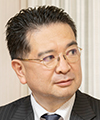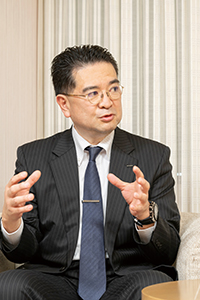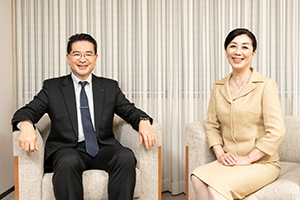 |
|
|
|
|
|
View from the Top Vol. 21, No. 5, pp. 1–5, May 2023. https://doi.org/10.53829/ntr202305tp1
Aiming to Attain Global No. 1 Technological Capabilities and Maximize the Value We Provide to Our ClientsAbstractNTT DATA creates new systems and value using information technology to contribute to creating a more prosperous and harmonious society. In accordance with the five strategies laid out in its medium-term management plan for FY 2022 to 2025, the company aims to establish a virtuous cycle of investment and growth and achieve business growth toward the Global 3rd Stage. Hiroshi Tomiyasu, senior vice president and head of Technology and Innovation General Headquarters, NTT DATA, is leading efforts toward this goal in terms of technology. We interviewed him about specific technology strategies and his belief as a top executive. Keywords: system integration, technology strategy, human resources Leading the Technology and Innovation General Headquarters—Could you tell us about the technology strategies of NTT DATA? NTT DATA is a global company that has grown over the past few years to employ 190,000 people worldwide. We have been striving to expand our business globally since FY 2005. In the Global 1st Stage, we increased our global coverage; in the Global 2nd Stage, we strived to establish a global brand; and in the Global 3rd Stage, we are aiming to become one of the top-five information technology (IT) service providers in the world. As the midpoint of the Global 3rd Stage, during the previous medium-term management plan for FY 2019 to 2021, we pursued profitable growth on a global scale with consistent belief and courage to change. To accomplish the Global 3rd Stage, under the current medium-term management plan for FY 2022 to 2025, we aim to create value by connecting people with technology and build a sustainable future in unison with our clients. To achieve this aim, we are pursuing the following five strategies: (i) Capitalize on the Convergence IT & Connectivity, (ii) Strengthen Consulting with Foresight, (iii) Evolve to an Asset-based Business Model, (iv) Enhance Advanced & Development Technology, and (v) Be the Best Place to Work. The Technology and Innovation General Headquarters, which I lead, plays the role of the headquarters for engineering teams scattered throughout Japan, the United States, and Europe. In accordance with our technology strategies for attaining global No. 1 technological capabilities and maximizing the value we provide to our clients, we are working on globally identifying and using not only the technology that can be used now but also the technology that will spread in the future through the application of advanced technology and co-creation research and development (R&D) to solve client problems. We are focusing on two of the five strategies of the medium-term management plan, Evolve to an Asset-based Business Model and Enhance Advanced & Development Technology. While identifying the technology areas to focus on, we are developing technology that will enable system development with high productivity and agility suitable for the digital age and provide that technology as global common assets. To continuously improve the value of such assets, we are also promoting the effective use of human resources with advanced technical skills. —It is a big role to take on two of the five strategies. Evolve to an Asset-based Business Model is likely to attract a lot of attention, isn’t it? Our business model has traditionally been system integration (SI) by which we develop a computer system tailored to each client’s needs. We have been engaged in sales activities through which we receive a request for proposal (RFP) from a client and develop a custom-made, one-of-a-kind system in accordance with the RFP. We will shift from this conventional SI to asset-based SI by fully demonstrating our ability to develop systems with client understanding and advanced technologies that we have cultivated thus far and our ability to support various enterprise systems and industry infrastructure to connect people, enterprises, and society. The background behind this initiative includes two challenges we must address: securing IT human resources and quickly responding to ever-changing environments and client requests. Regarding the former challenge, expanding sales while maintaining the conventional SI business model necessitates executing many projects with considerable human resources. However, the global competition for IT talent is heating up, so it is not always possible to secure those human resources. It is therefore important to shift from custom-made system development, and we have decided to pursue a business model in which the NTT DATA Group’s technologies, knowledge, and experience are consolidated into assets at the global level and effectively used in multiple regions and industries. Regarding the latter challenge, as the use of digital technology accelerates business, the conventional SI business model cannot keep up with such speed. Accordingly, we will evolve our business model to one in which we proactively propose and disseminate our products and services by leveraging our assets so that we can acquire the business agility suited to the digital age and maximize the value we provide to our clients. Assets can be many things, but we mean reusable assets such as industry and business foresight, best practices, software, and in-house tools. The Technology and Innovation General Headquarters is responsible for creating common global technology assets, and we are selecting global technology focus areas and developing industry-independent technology assets in each area. By expanding the scale of sales, increasing the number of engineers, and building an ecosystem by strengthening partner alliances in each area, we aim to acquire global No. 1 technological capabilities and accelerate our transformation to an asset-based business model by taking advantage of such capabilities.
Reorganizing R&D and technology-development activities on the basis of Emerging, Growth, and Mainstream categories—Could you explain the other strategy, Enhance Advanced & Development Technology? This is a key strategy for turning our technology into our business by strengthening our ability to use advanced technology to gain future competitiveness and system-development technology to improve productivity. We first divided these technologies into three categories—Emerging, Growth, and Mainstream—in accordance with the maturity level of each technology and reorganized our R&D and technology-development activities on the basis of these categories. In the Emerging category, we will search for advanced technologies that will be available five to ten years from now and conduct co-creation R&D that examines value creation with clients by using new technologies. In the Growth category, we will develop technologies to create growth business and technology-focus areas in three to five years, create technology assets, and conduct business-feasibility tests as well as train engineers. In the Emerging and Growth categories, we will begin full-fledged development of our technology assets to achieve global business expansion from a technological standpoint. The Innovative Optical and Wireless Network (IOWN) is a priority theme for creating new social value, and we are collaborating with NTT laboratories, which conduct R&D on component technologies for IOWN. In particular, we are developing a common testbed so that their research results can be commercialized and delivered to our clients. We are also promoting a digital twin co-creation program for conducting co-creation R&D with our partners engaged in social innovation. In the Mainstream category, we will develop technology assets in technology-focus areas concerning current business, unify our global strategy to expand our business in Japan, the United States, and Europe, increase delivery resources, and expand market share. The main technology-focus areas in this category include “cloud” for system development using various cloud services; “application development and management,” which pursues highly agile system development and productivity improvement by using digital technologies; “cybersecurity,” which focuses on security services on the basis of the concept of zero trust, rather than the conventional perimeter defense; and “data and intelligence,” which intends to create new business value through data analysis and data utilization by using artificial intelligence (AI). —The reorganization of the Technology and Innovation General Headquarters seems to be a flagship initiative for the business transformation of NTT DATA. I think it is a touchstone rather than a flagship. As I mentioned at the beginning, NTT DATA has grown into a company with 190,000 employees worldwide. This growth process involved mergers and acquisitions, and business styles of each company, business practices and business processes in each country, and characteristics and needs of clients all differ. As we standardize, and in some cases, integrate these different practices and systems and strategically establish NTT DATA’s identity, we must accommodate the different needs of our clients in each region. This process will take a considerable amount of time; however, in a sense, the technologies are the same worldwide, so they are easy to unify, therefore, we unified and shared the technology strategies ahead of business practices. Of course, some things will go wrong because it is the first time. Accordingly, we have changed our approach to business plans; that is, we implement them speedily and revise them as necessary. Specifically, we review business plans every three months with executives from each country in reference to the status of their implementation. Since we constantly monitor and undergo major revisions every three months, I do not have time to be satisfied or dissatisfied with the progress of the business plans. I work with the mindset that the repetition of working enthusiastically will lead to a job well done later. When making this assessment, in addition to the usual indicators, one of the points to consider is whether a project is in a busy state. I think the work we have done to the best of our abilities while saying, “It’s so tough,” is probably that in which we look back on later and think, “That was interesting and fulfilling.” I have had this experience myself, and I take into consideration whether the project members are engaged in the project enthusiastically.
Developing human resources with enthusiasm—Could you tell us what is important to you as a top executive? I entered NTT DATA in 1990 and studied image-recognition systems at the R&D department for about ten years. However, due to the company’s decision to stop developing image-recognition systems in the light of the background of that time and future potential, I was transferred to a department related to financial systems. I learned an important lesson from that experience. That is, it is important not to continue a project simply by force of habit; instead, it is necessary to have a strong conviction to withdraw or change course in a timely manner. NTT DATA is now a global company with 190,000 employees, and if we continue to work by inertia, those 190,000 employees will go in the wrong direction. That is why we share NTT DATA’s clear technology strategies for global integration with engineers around the world while promoting transformation with conviction. It is also important to have a good sense of whether a technology being developed will be accepted by clients and whether it is likely to become popular. It is necessary to develop technologies that can address issues that front-line employees found in direct communication with clients and create products that front-line employees can propose to clients while confidently saying, “We can solve your problems with this technology.” However, engineers tend to be somewhat distant from the field, thus end up developing technologies on the basis of their own ideas and proposing the results of that development to clients. Unfortunately, technologies and services developed through that process are often dismissed by clients. For these reasons, I value timely decisions taken by the front-line employees. —I see that you value the perspective from the front line. Finally, what would you like to say to people inside and outside the company? I strive to develop human resources with enthusiasm. As for nurturing people, it is important to have the ability to identify who they are and what kind of sense they have. That is because not everyone grows up in the same time or at the same rate. If people’s growth rates differ, so will their senses. I believe that the ability of top executives is determined by whether they can give a job that matches the individuality of each employee. We always keep in mind that we need to assess the individuality of the person we want to nurture in terms of whether the job is too difficult or too easy for them. I would like to say to our partners that global competition for talent has become increasingly fierce. The media reports on layoffs at global technology companies may lead you to believe that the IT workforce is already saturated; the reality is different. Information and communication technology is changing at a dizzying pace, and the human resources required are changing as well. Therefore, we are competing to acquire human resources who can cope with that change. Moreover, with the advent of various types of AI, it is easy to imagine that all computer systems will be replaced with AI in the future. However, it is people who are operating those systems, and computer systems and software will continue to be necessary. That is why people will continue to be important. I want to work together in taking responsibility for nurturing not only people within our company but also all our partners. I would like to say to our clients and prospective clients that our highly skilled employees are ready to meet your needs and I hope you will choose us. Finally, I’d like young engineers to immerse themselves in the study of technology and, as the common adage goes, “forget about eating and sleeping.” The value of software and computer system technologies is determined by whether people use them, so if you have the chance, gain experience in the field while you are still young and grow as an engineer.
Interviewee profileCareer highlightsHiroshi Tomiyasu joined NTT DATA Communications Systems Corporation (currently NTT DATA Corporation) in 1990. In his career at NTT DATA, he became general manager of the Research and Development Headquarters in 2007, head of the Center for Applied Software Engineering of Research and Development Headquarters in 2011, head of the System Architecture Department of the Infrastructure System Sector, Technology and Innovation General Headquarters in 2015, and head of the System Engineering Headquarters of the Technology and Innovation General Headquarters in 2017. He assumed his current position in June 2020. |




